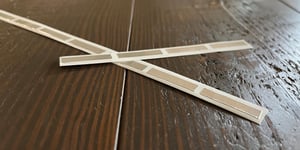If your phone glitches, you restart it, but what happens when disturbances affect critical devices like patient monitors?
Electromagnetic interference is unwelcome due to the technical issues it can cause in devices, so engineers often imbed technology with EMI shielding gaskets.
From tiny wearable devices to massive EV batteries, Strouse has helped produce a wide range of EMI shielding gaskets to protect critical applications. Once you’ve reviewed these examples, you’ll understand precisely what an EMI shielding gasket is, its purpose, and what they’re made of.
What is an EMI Shielding Gasket?
Standard gaskets create a seal between two surfaces, blocking out substances such as air or water. In the case of EMI shielding gaskets, they block outside interference from damaging technology.
Electronic devices emit outside interference that can affect the performance of other devices. In today’s world, where most adults carry a handheld device, this level of interference is only growing.
EMI VS. RFI SHIELDING GASKETS
The two primary types of interference are electromagnetic interference (EMI) and radio frequency interference (RFI). Although we will primarily discuss EMI gaskets, many of these materials can also block out radio frequencies.
EMI shielding gaskets are barriers that ward off stray signals and frequencies, protecting electronic equipment from malfunctions and damage. Depending on the situation, EMI gaskets can be placed on the object emitting the interference in or on the technology at risk of damage.
How do EMI Gaskets Work?
EMI gaskets are created using dampening materials that are thick or conductive enough to repel electromagnetic waves.
All EMI gaskets rely on a precise fit, accurate coverage, and effective materials to minimize interference as much as possible. Their design can be relatively standard, such as circular gaskets found at the hardware store, or custom, which involves placing an order with a flexible material converter.
Manufacturers create EMI gaskets by designing and cutting damping materials into shapes that encompass device openings or surfaces. These gaskets are then laminated with adhesive on one or both sides in order to create a sturdy seal that blocks out signals.
What is the Purpose of the EMI Gasket?
Electromagnetic interference can disturb the sensitive inner workings of a device and cause technological malfunctions. The purpose of an EMI gasket is to contain or block interference from passing through a surface, whether it’s the emitter’s surface or the device at risk of disturbance.
EXAMPLES OF EMI GASKETS
EMI gaskets are used in a wide range of applications.
a. PRINTED CIRCUIT BOARDS
One of the most common examples of EMI gasket shielding is on printed circuit boards (PCBs), where either individual layers, pieces, or the entire board is covered in shielding material to prevent cross-talk between components.
b. PATIENT MONITORING DEVICES
Within the medical industry, EMI shielding gaskets protect critical patient monitoring and communication devices.
c. DATA PRIVACY AND SAFETY
In military and governmental applications, EMI gaskets protect sensitive information on computers and other systems. Additionally, consumer goods like EMI-protected phone cases or bags can shield contactless payment methods, such as phones and debit or credit cards, from modern pickpocketing.
Lastly, EMI gasket shielding can also apply to cables, ventilation openings, and Faraday cage doors.
What are the Different EMI Gasketing Materials?
Your choice of EMI gasketing material will depend on the necessary manufacturability, shielding capabilities, and compatibility with the surrounding device components.
Many EMI gasketing materials are made from nickel or iron alloys due to their high conductivity. Other potential EMI gasketing materials include copper, aluminum, and silver. This brings us back to Faraday cages, which are often constructed using electrically conductive EMI gasketing materials.
- EPDM rubber is weather and heat-resistant, and certain EPDM EMI gaskets can be used to shield outdoor electronic devices from environmental conditions.
- Silicone EMI shielding gaskets are similarly used due to their resistance towards UV light, ozone, and chemicals, making silicone gaskets fit airplanes, space shuttles, and similar crafts.
For watertight or heavy-duty gasketing applications requiring EMI shielding, foam gasket tape can often achieve the strength or bonding power necessary to hold a seal.
If you’re looking for a large quantity of EMI gaskets, you’ll want to ensure you’re ending up with the best possible cost. Find out what affects the cost of a custom gasket to determine whether your next step involves seeking a flexible material converter.
Where Can I Find EMI Shielding Gaskets?
Finding the right EMI shielding gasket largely depends on the material and quantity you’re searching for.
Uncommon materials could be more challenging to find, and thanks to their minimum order quantities, they could be far more expensive if you’re only looking for a small amount.
If you’re looking for a handful of geometrically simple, premade EMI shielding gaskets for your own use, you shouldn’t have an issue finding them. Yet, suppose you’re using difficult-to-cut gasket materials, searching for a large quantity, or using a drawing with unusual shapes or angles. You'll need to find just the right material for your design. Luckily, we can give you a starting point regarding EMI materials:
Originally published June 2, 2023








